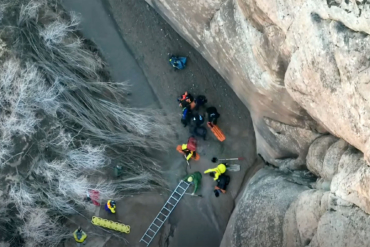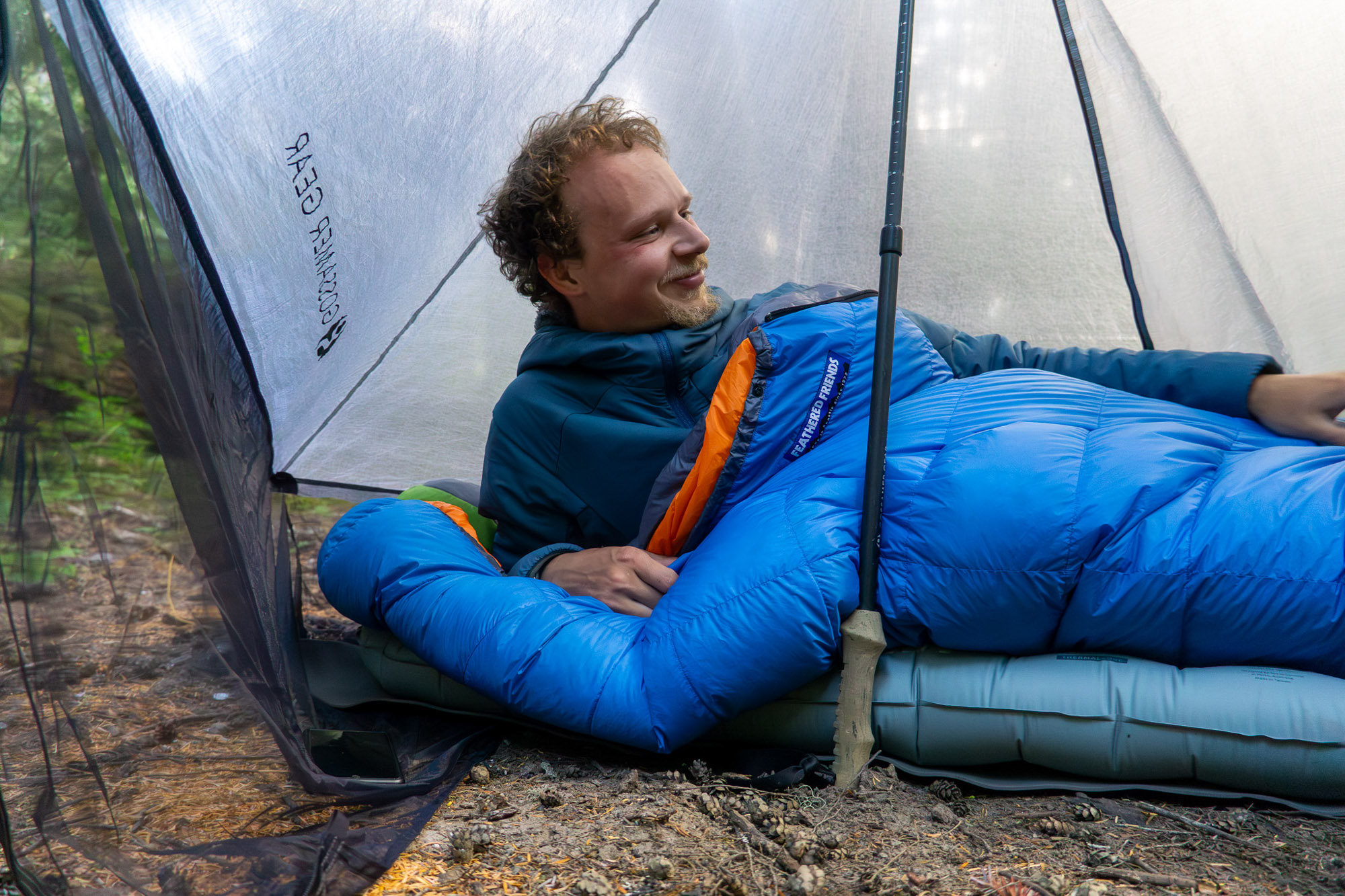In March 2018, I set off on my grand adventure of thru-hiking the Appalachian Trail (AT), a 2,200-mile continuous trail between Georgia and Maine. It was a dream I’d had since I was 11 years old. I was on an overnight summer camp backpacking trip in New Hampshire at Mizpah Spring Hut in the White Mountains. Two women who were hiking the whole Appalachian Trail together were the guest speakers, talking about their experiences.
My friend and I looked at one another and said, “Let’s do that when we’re older.”
Years later, after graduating college, the time was perfect. I didn’t have a job yet and I’d finished all my studies. So I started preparing for that lifelong goal and adventure.
I had researched and invested in some gear ahead of that first thru-hike attempt. But most of what I ended up taking had been thrifted or gifted. I firmly believe I could have made it to Katahdin with what I had. But at Harpers Ferry, I had to get off for personal reasons. My first thru-hike attempt had been derailed.
This March, though, I’m returning to Springer Mountain with a new setup, determined to finish what I started with even better gear. Here’s what I’m changing about the packing list, what I’m leaving behind, and what I’ve upgraded. If you’re considering your own Appalachian Trail thru-hike — whether it’s on the AT, Pacific Crest Trail, the Continental Divide Trail, or any other — you might be able to learn something from my mistakes.
Updating My Appalachian Trail Thrifted and Gifted Gear

What I Changed
Before setting off on the Appalachian Trail for the first time, I had been backpacking about two or three times. One included hiking down to natural hot springs in Colorado and carrying a pumpkin pie in my pack. We carried everything in our backpacks for the multiday trip. So I would still call it “backpacking.” But we definitely weren’t counting the ounces.
I thought I was making good decisions for the Appalachian Trail thru-hike. But like everyone heading out for the first time, there was a much-needed shakedown once I got out there. People who were more experienced backpackers looked at my things and asked why I was carrying a physical journal, a map, data, a guidebook, and other small accessories. My pack didn’t feel too heavy. But I quickly learned that every ounce matters.
Planning for this second attempt was the perfect opportunity to upgrade my gear and fill my pack with the ounces I actually needed.

Footwear
Prior to my 2018 attempt, I went to REI to get good hiking boots. I worked with an employee for quite a while to get the size and fit dialed in. And they had felt fine in the store. But on the trail, it was a different story. I even had sock liners, and my feet still got many blisters. The hike continued, but each step was so painful I knew I had to change them as soon as possible.
I hobbled into Franklin, N.C., right after the 100-mile mark, and into the local retailer, Outdoor 76. The man at the store suggested I size up to account for my feet swelling from hiking so much. He said whichever shoe felt the most comfortable at that moment would feel like clouds when my feet healed. He was right. The Saucony shoes I picked felt wonderful.
The Saucony shoes were for running on pavement, but they felt fantastic on the trail. I hiked until mile 1,013 with that style. And to this day, I am loyal to Saucony. These shoes fit wider feet, are much more flexible than boots, and still support me well.
The weight difference between hiking boots and trail running shoes is massive. My prior Oboz hiking boots weighed 33 oz, and the Saucony trail runners weigh just 9.8 ounces. That weight reduction made a huge difference with each step on the trail. Some people prefer taller, stiffer boots that offer more ankle or arch support. But if you can make trail runners work, they cut a lot of weight.
I also changed the type of liners I was using from sock fit to individual toe fit (Injinji). That extra fabric between the toes really helped minimize friction, so I barely got any blisters.
Hiking Dresses and Sun Hoodies
In 2018, I hiked in shorts I had found in a free clothes pile at school and shirts from Target. This year I’m planning to mainly wear the Columbia PFG Freezer III dress because I find it incredibly comfortable (read my full review to learn more).
I’m also packing my Jolly Gear sun hoodie, which I’m excited to wear. Designed by a thru-hiker (trail name “Jolly”) for thru-hikers. The company’s tagline is “where fun meets functional.” I love supporting others in the thru-hiking community. And anyway, it’s just a cool hoodie that protects me from getting too much sun.

Appalachian Trail Thru-Hike: The Pack
The backpack that I used on my first Appalachian Trail thru-hike attempt was the REI Crestrail 65, which I bought in 2013. It was a great pack. But it was 4 pounds, 5 ounces. And obviously, pack technologies and pack weights have come a long way in the last decade. The Osprey Eja 58 will take its place this year. The Eja 58 is 2 pounds, 8 ounces; cutting 1 pound, 7 ounces from my pack weight will make a noticeable difference without sacrificing comfort.
I’ve used a Hyperlite 2400 Junction Pack in the past for shorter hikes, which I’ve loved. But I’m choosing the Osprey Eja 58 for a thru-hike as long as this one. Why? The Osprey is 9 ounces heavier than the Hyperlite. But I believe the comfort provided by the mesh back of the Osprey will be worth that extra weight.
Appalachian Trail Thru-Hike: Accessories
I had a lot of small things that I either thought I needed or were gifts. And because they were so small, I thought, why not? I can carry a few extra items even if I don’t need them.
I definitely shipped a few things home when I arrived in the first town. There was a portable solar charger that wasn’t as effective as I needed it to be. It had to go. I also had a data book with all the shelters and campsites listed. I ended up taking photos of the pages instead and sent the physical book home. Then there were a bunch of small carabiners I never used. I even had a clothesline (thank you for the gift, Dad!), but I didn’t use it enough for it to make sense.

This time around, my accessories are all thought-out.
I’m willing to carry my camera and the charger to capture my experience. My Therm-a-Rest pump is also a necessary luxury. It keeps the sleeping pad cleaner as I won’t use my breath to blow it up. It also makes setting up camp much easier after a long day, and I know I will use it every night. Thank you for that recommendation, Alina (trail name “Abstract”).
Full Gear List for the Appalachian Trail

Apparel
- Shell: Outdoor Research Helium Rain Jacket
- Down jacket: Mountain Hardwear Ghost Whisperer/2 Down Hoodie
- Midlayer:
- Base layer: Smartwool Classic Thermal Merino Crew Base Layer Top
- Pants/Shorts:
- Rain pants: Outdoor Research Helium Rain Pant
- Undergarments:
- Shoes: Saucony Peregrine 11 Trail Running Shoe
- Insoles: Superfeet Custom Hiking Insoles
- Socks: Darn Tough Micro Crew Hiking Socks (two pairs)
- Liners: Injinji Liner Crew Wool Socks (two pairs)
- Camp shoes: Crocs Classic Clogs
- Gloves: Arc’teryx Venta Gloves
- Hats:
- The North Face Salty Bae Beanie (for winter)
- REI Co-op Out the Door Cap (for sun)
- Storage:
Gear
- Tent:
- Pack:
- Sleeping bag: Feathered Friends Ultralight Quilt Down Sleeping Bag
- Liner: Cocoon Expedition Liner
- Sleeping pad: Therm-a-Rest NeoAir XLite Sleeping Pad (included in “The Best Backpacking Sleeping Pads of 2023“)
- Pillow: Sea to Summit Aeros Ultralight Pillow
- Pump: Them-a-Rest NeoAir Micro Pump
- Stove: Jetboil Stash Cooking System
- Kitchenware:
- Water filtration:
- Nalgene, 32 oz. water bottle
- First aid kit: Adventure Medical Kits Ultralight/Watertight .5 Medical Kit
- Headlamp: Black Diamond Cosmo 350-R Headlamp
- Seat cushion: Therm-a-Rest Z Seat Cushion Insulated Sitting Pad
- Trowel: Vargo Titanium Dig Dig Tool
- Trekking poles: Black Diamond Equipment WS Trail Ergo Cork Trek Poles
- Electronics:
- Sunglasses: goodr OGs Sunglasses
- Stickers:
- Pins:
- Bodyglide: Bodyglive Foot Glide 0.8 oz.
- Storage:
Packing for My Appalachian Trail Thru-Hike: Conclusion

With so many items gifted or thrifted in 2018, I didn’t have a lot of choice about what to use. This time, I hand-selected gear that would work for me. I feel much more prepared. I’ve spent the past 4 years backpacking whenever I could and had the opportunity to work in an outdoor store. So I’m also much more knowledgeable about gear in general.
Over the years, I’ve switched to ultralight items like a Hyperlite Mountain Gear tarp tent, Hyperlite pack, and even a Therm-a-Rest NeoAir UberLite sleeping pad. They were great. But they didn’t have the comfort level I was looking for in a thru-hike. I’ll be using this gear every day, so I want to make sure I love every aspect of it — not just the weight.
My base weight of everything minus food and water is 17 pounds, 9 ounces. While I would always want it to be lighter, I am prioritizing comfort and enjoyment on the AT. My pack is much more of a lightweight backpacking setup than an ultralight setup, but I believe it will work well for me.
When it comes to gear, the amount of use and enjoyment will justify the weight. Use this gear list as a guide for your next adventure, whether it’s a shorter backpacking trip or a thru-hike. Hike your own hike — and happy trails!








